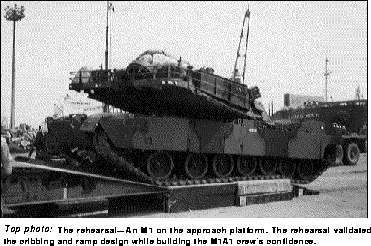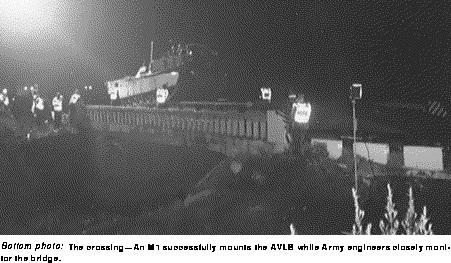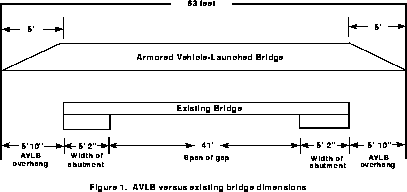The AVLB: Still a Viable Mobility Asset
 AVLB
AVLB
The AVLB: Still a Viable Mobility Asset
By Second Lieutenant Robert Dieter
In July 1995, U.S. Army engineers provided support to the Marine Corps during Operation Freedom Banner in the Republic of Korea. Marines stationed in Okinawa traveled to the eastern seaport of Pohang to exercise their sea-stationed equipment. Army combat engineers from the 2d Engineer Battalion of the 2d Infantry Division provided mobility support along the routes used during the exercise. The mission proved to be an educational experience for both the Marine and the Army engineers.
During the initial reconnaissance of the route to the MlAl training range, the III Marine Expeditionary Force (MEF) discovered a military load classification 18 bridge that had neither a bypass nor a ford site. An Army combat engineer team from Charlie Company, 2d Engineer Battalion, conducted a bridge reconnaissance to determine the options available to cross the Marine's MlAl tanks and supporting equipment. The concrete bridge spanned a gap of 41 feet with a 5-foot-2-inch abutment at each end. The bridge had an 8-inch rise in the center to allow water to run off. The team determined that, if cribbed, an armored vehicle-launched bridge (AVLB) could span the gap, enabling the Marine detachment to cross. Figure 1 shows a comparison of the existing bridge to the AVLB.

The AVLB is a a 15-ton aluminum alloy bridge mounted on a 48-ton M60 chassis. It is designed to cross vehicles up to 60 tons over a 60-foot gap. With the development of the 67-ton MlA1 Abrams tank, the AVLB was approved to cross vehicles up to 70 tons in a "caution crossing" over a 50-foot gap. However, the following stipulations exist when crossing vehicles weighing more than 60 tons:
- Vehicles must not stop on the bridge. Movement prevents the full weight of the vehicle from occupying the same space, which could cause the bridge to buckle.
- Vehicles must not turn or adjust their alignment on the bridge. The ground guide must have the vehicle lined up properly before it drives onto the bridge. This is particularly important for tracked vehicles because steering them on the bridge might cause the turning tracks to tear up the bridge panels.
- All four center pins of the bridge must be in place to provide additional stability. This stability is needed to decrease the amount of deflection that occurs as the vehicle approaches the bridge's center of mass.

Two AVLB teams from Charlie Company, 2d Engineer Battalion, provided mobility support for the III MEF. After conducting their own evaluation of the bridge site, the AVLB teams linked up with the Marine engineer officer in charge to discuss the cribbing requirements. They determined the rise of the existing bridge then consulted the operator's manual and estimated that the AVLB would deflect from 2 to 5 inches when an MlA1 reached the bridge's center of mass. They decided that the cribbing should rise 16 inches above the ground level to provide a 3-inch safety factor. Both ends of the AVLB required cribbing. The final cribbing was 3 feet wide and spanned the width of the bridge. Marine and Army engineers constructed two sets of cribbing by modifying 8x8x10, 8x8x16, and 8x8x20 dressed timbers. They banded both sets together to restrict movement when the MlAls entered and exited the bridge. Banding also allowed material-handling equipment to rapidly emplace and remove the cribbing material.
The next challenge was to get the Abrams tanks up to the level of the bridge, which was now elevated 16 inches. The AVLB operator's manual calls for a 3-foot gap between the beginning of the bridge and the cribbing. Using a straight ramp from the ground to the elevated bridge caused concern for two reasons:
- As a tank drove onto the bridge, it could shift the bridge forward and create a gap between the ramp and the AVLB. The gap would grow larger as each tank crossed.
- If a gap was created, the weight of an approaching MlA1 might use the cribbing as a fulcrum and cause the bridge to see-saw.
To alleviate these concerns, the engineers constructed an approach platform long enough to hold most of a tank before it crossed the bridge. The platform was slightly higher than the 16-inch cribbing. They incorporated the added height for the approach platform so the MlA1 would come down on the entrance ramp of the AVLB instead of meeting the forward edge of the bridge head-on. This reduced the risk of the tanks pushing the bridge forward and lessened the shock on the tie-rods located at each end of the bridge. Based on these considerations, they constructed the approach platform in two pieces. They banded each section together to prevent the lumber from shifting and to assist in rapid emplacement and removal. An exit platform was not required because the bridge would not shift as a tank exited. The completed approach platform was 12 feet long and 17 inches high and spanned the width of the bridge.
The engineers constructed two ramps: one to bring the tank onto the approach platform and a second to bring the tank off the bridge at the same declination. Both ramps were modified 8x8x10 lumber planks stacked to an incline and decline, respectively. The exit ramp was 2 feet longer than the entrance ramp because there was no exit platform; the extra 2 feet were required to maintain the same declination slope. Figure 2 shows the final plan for the cribbing, platform, and en-trance ramp.
After the engineers completed the construction, they conducted a rehearsal to measure the actual deflection of the AVLB as the tanks crossed and to see how the MlAl crews handled entering and exiting the bridge. Front loaders moved and shifted the heavy cribbing bundles, approach platforms, and ramps into place. Once the cribbing was set, the AVLB launched the bridge on the cribbing and moved to a secure location so the platform and ramps could be emplaced. After the engineers completed the set-up, they ground-guided each tank across the bridge. They crossed seven tanks during the rehearsal with an average of 3.5 inches of deflection, measured with the tanks at the bridge's center of mass and the center pins inserted. The greatest deflection was 4 inches and the least was 2.75 inches. The rehearsal verified the planning factors and allowed the MlA1 crews to gain confidence and experience in crossing a gap on an AVLB. They detected no problems during the rehearsal, and the AVLB had no problems launching and releasing the bridge, in spite of having to launch onto the 16-inch cribbing.
The crossing for the exercise took place at midnight to minimize disruption to civilian traffic. Initial planning called for a 4-hour window of operation. Due to the close coordination of Army and Marine engineers and the full-scale rehearsal, it took only 55 minutes to emplace the cribbing, launch the bridge, cross the MlAls, and remove the bridge and cribbing. The time was reduced to 41 minutes during the return crossing.
Combat engineers of the 2d Engineer Battalion were continuously challenged by Korea's mountainous terrain and the lack of fording sites at streams and rivers. However, crossing the Marine detachment gave them valuable mobility experience. More importantly, Operation Freedom Banner clearly de-monstrated that the AVLB is still an effective tool for mobility operations.
Second Lieutenant Dieter is the Assault and Obstacle Platoon Leader of C Company, 2d Engineer Battalion, Republic of Korea. He is a graduate of the Engineer Officer Basic Course, Airborne School, and Ranger School. Second Lieutenant Dieter holds a bachelor's degree from Creighton University, Omaha, Nebraska.



 AVLB
AVLB

